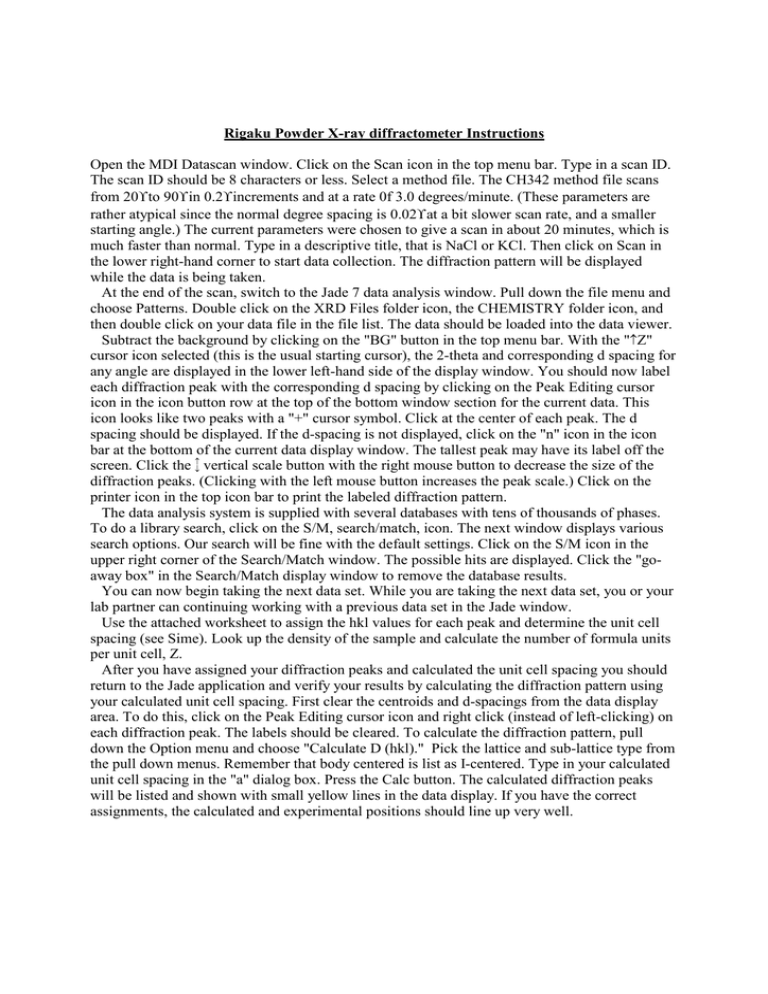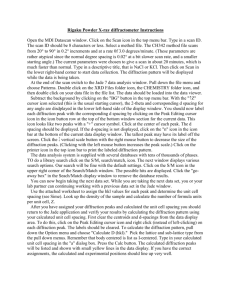Rigaku Powder X-ray diffractometer Instructions Open the MDI
advertisement

Rigaku Powder X-ray diffractometer Instructions Open the MDI Datascan window. Click on the Scan icon in the top menu bar. Type in a scan ID. The scan ID should be 8 characters or less. Select a method file. The CH342 method file scans from 20° to 90° in 0.2° increments and at a rate 0f 3.0 degrees/minute. (These parameters are rather atypical since the normal degree spacing is 0.02° at a bit slower scan rate, and a smaller starting angle.) The current parameters were chosen to give a scan in about 20 minutes, which is much faster than normal. Type in a descriptive title, that is NaCl or KCl. Then click on Scan in the lower right-hand corner to start data collection. The diffraction pattern will be displayed while the data is being taken. At the end of the scan, switch to the Jade 7 data analysis window. Pull down the file menu and choose Patterns. Double click on the XRD Files folder icon, the CHEMISTRY folder icon, and then double click on your data file in the file list. The data should be loaded into the data viewer. Subtract the background by clicking on the "BG" button in the top menu bar. With the "↑Z" cursor icon selected (this is the usual starting cursor), the 2-theta and corresponding d spacing for any angle are displayed in the lower left-hand side of the display window. You should now label each diffraction peak with the corresponding d spacing by clicking on the Peak Editing cursor icon in the icon button row at the top of the bottom window section for the current data. This icon looks like two peaks with a "+" cursor symbol. Click at the center of each peak. The d spacing should be displayed. If the d-spacing is not displayed, click on the "n" icon in the icon bar at the bottom of the current data display window. The tallest peak may have its label off the screen. Click the ↑↓ vertical scale button with the right mouse button to decrease the size of the diffraction peaks. (Clicking with the left mouse button increases the peak scale.) Click on the printer icon in the top icon bar to print the labeled diffraction pattern. The data analysis system is supplied with several databases with tens of thousands of phases. To do a library search, click on the S/M, search/match, icon. The next window displays various search options. Our search will be fine with the default settings. Click on the S/M icon in the upper right corner of the Search/Match window. The possible hits are displayed. Click the "goaway box" in the Search/Match display window to remove the database results. You can now begin taking the next data set. While you are taking the next data set, you or your lab partner can continuing working with a previous data set in the Jade window. Use the attached worksheet to assign the hkl values for each peak and determine the unit cell spacing (see Sime). Look up the density of the sample and calculate the number of formula units per unit cell, Z. After you have assigned your diffraction peaks and calculated the unit cell spacing you should return to the Jade application and verify your results by calculating the diffraction pattern using your calculated unit cell spacing. First clear the centroids and d-spacings from the data display area. To do this, click on the Peak Editing cursor icon and right click (instead of left-clicking) on each diffraction peak. The labels should be cleared. To calculate the diffraction pattern, pull down the Option menu and choose "Calculate D (hkl)." Pick the lattice and sub-lattice type from the pull down menus. Remember that body centered is list as I-centered. Type in your calculated unit cell spacing in the "a" dialog box. Press the Calc button. The calculated diffraction peaks will be listed and shown with small yellow lines in the data display. If you have the correct assignments, the calculated and experimental positions should line up very well. Powder X-ray Diffraction Name____________________________ d 1/d2 M=h2+k2+l2 exact M a Substance 1_____________ Substance 2________________ a _____________________cm a _____________________cm density_________________g/cm3 density_________________g/cm3 FW____________________g/mol FW____________________g/mol density_________________molecules/cm3 density_________________molecules/cm3 V unit cell______________cm3 V unit cell______________cm3 z______________________formula units per unit cell z______________________formula units per unit cell Structure: primitive, BCC, FCC Structure: primitive, BCC, FCC

